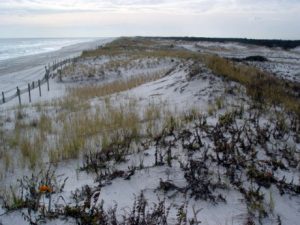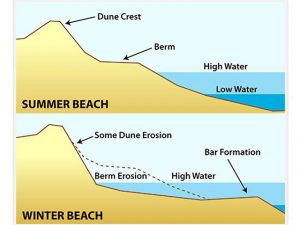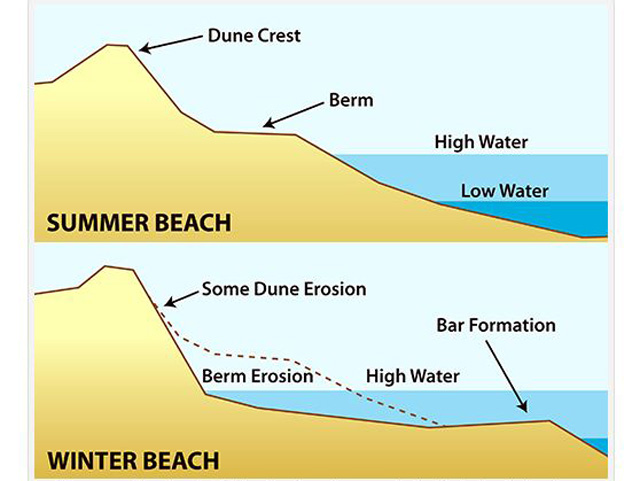This is the sixth installment of the “Science of the Shore Column" written by Bianca Charbonneau, Phd candidate. Have a science question you would like answered? Email Bianca at [email protected]
Most beachgoers only visit the beach in the summer when the conditions are great for tanning and swimming – mild wind, warm water, high temperatures, and strong sun! However, not all beach-goers are fair-weather fans. Many people visit year-round and will have noticed that a beach looks very different in winter and summer.
 Scientists often refer to beaches’ profile (a cross-shore measure of elevation from the dune to the water across the beach), and there are both summer and winter profiles for each beach due to variation in wind and wave energy between seasons.
Scientists often refer to beaches’ profile (a cross-shore measure of elevation from the dune to the water across the beach), and there are both summer and winter profiles for each beach due to variation in wind and wave energy between seasons.
In general, along the mid-Atlantic, seasonal variation in prevailing wind direction and speed results in larger waves in the winter months.
Prevailing winds are from the southwest in summer and from the northwest in winter while storms and northeast wind (nor’easters), which have the most potential to cause coastal erosion, occur mostly in the fall.
Regardless of direction, wind speed is greater in the winter because of the increased temperature difference between the poles and equator. Air movement is caused by uneven heating, so as the difference between the temperature of the poles and equator increases, so does wind speed because the temperature gradient causes warm air rising from the equator to be more quickly replaced by air from the poles.
You’ll recall that wind speed, direction, and fetch create waves meaning that the increase in wind speed and a change in direction will result in bigger winter waves that cause greater erosion and result in two very different beach profiles. 
Gentler summer waves deposit sand from offshore bars onto the beach, ultimately widening it and increasing its elevation. Conversely, stronger winter waves with more energy, pick up those particles deposited in the summer, and carry them back offshore in bars, thus narrowing the beach. These offshore bars work to help buffer the beach during the winter from erosion as they cause waves to break further offshore.
While people put on more layers (of clothes) on throughout the winter, beaches have their layers (of sand) taken off! The size of the sand particles carried offshore in any time period will largely depend on wave energy because larger particles require more energy to be moved. As a result, the sand composition of a beach in winter will be much coarser than in summer when finer and medium-grain sands predominate.
And if the cold wind and beach profile were not obvious signs that you were standing on a winter beach, then look to the plants! During the summer the dune plants are green and blowing in the breeze. However, during the winter, the plants go dormant with only the roots remain alive. The above ground, leaves and stalks die and become like straw in color and rigidity; however, the plant roots and above ground matter, while dead, are still working to hold the dune together and prevent erosion.
The wide summer beaches we love, change drastically in winter, but usually all, or most, of the offshore sand is returned to the beach in spring and summer, unless storms move it to deeper water!




